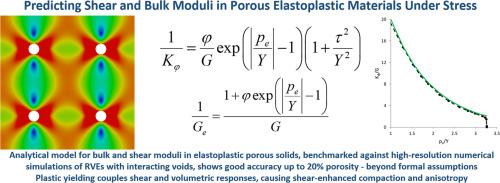Benchmarking effective moduli in porous elastoplastic materials
IF 9.4
1区 工程技术
Q1 ENGINEERING, MECHANICAL
International Journal of Mechanical Sciences
Pub Date : 2025-09-17
DOI:10.1016/j.ijmecsci.2025.110854
引用次数: 0
Abstract
Predicting the mechanical behavior of porous elastoplastic materials under stress is critical in fields such as geomechanics, energy storage, and impact engineering. However, most existing analytical models are limited to linear elastic or viscous matrices and fail to capture the effects of plastic yielding and shear loading. In this study, we derive new closed-form expressions for the effective shear modulus of porous elastoplastic solids, extending prior work on effective bulk modulus under non-hydrostatic loading. We show that plastic yielding leads to a coupling between shear and volumetric responses - specifically, a dependence of the effective bulk modulus on shear stress and of the shear modulus on mean pressure. This coupling results in shear-enhanced compaction and stress-induced anisotropy in initially isotropic materials. The analytical solutions for the effective bulk and shear moduli are benchmarked against high-resolution numerical simulations of representative volume elements containing multiple interacting voids. Results demonstrate that the model remains accurate even at porosities up to 20 %, well beyond its formal assumptions. These findings provide a physically grounded, computationally efficient approach to capturing key nonlinear effects in porous elastoplastic media.

多孔弹塑性材料有效模量的基准测试
预测多孔弹塑性材料在应力作用下的力学行为在地质力学、储能和冲击工程等领域至关重要。然而,大多数现有的分析模型仅限于线弹性或粘性矩阵,未能捕捉塑性屈服和剪切载荷的影响。在这项研究中,我们推导了多孔弹塑性固体有效剪切模量的新封闭表达式,扩展了先前关于非静水载荷下有效体积模量的工作。我们表明,塑性屈服导致剪切和体积响应之间的耦合-具体而言,有效体模量依赖于剪切应力和剪切模量依赖于平均压力。这种耦合导致剪切增强的压实和应力诱导的各向异性。有效体积模量和剪切模量的解析解以包含多个相互作用空隙的代表性体积单元的高分辨率数值模拟为基准。结果表明,即使在孔隙率高达20%的情况下,该模型仍然是准确的,远远超出了其正式假设。这些发现为捕获多孔弹塑性介质中的关键非线性效应提供了一种物理基础、计算效率高的方法。
本文章由计算机程序翻译,如有差异,请以英文原文为准。
求助全文
约1分钟内获得全文
求助全文
来源期刊

International Journal of Mechanical Sciences
工程技术-工程:机械
CiteScore
12.80
自引率
17.80%
发文量
769
审稿时长
19 days
期刊介绍:
The International Journal of Mechanical Sciences (IJMS) serves as a global platform for the publication and dissemination of original research that contributes to a deeper scientific understanding of the fundamental disciplines within mechanical, civil, and material engineering.
The primary focus of IJMS is to showcase innovative and ground-breaking work that utilizes analytical and computational modeling techniques, such as Finite Element Method (FEM), Boundary Element Method (BEM), and mesh-free methods, among others. These modeling methods are applied to diverse fields including rigid-body mechanics (e.g., dynamics, vibration, stability), structural mechanics, metal forming, advanced materials (e.g., metals, composites, cellular, smart) behavior and applications, impact mechanics, strain localization, and other nonlinear effects (e.g., large deflections, plasticity, fracture).
Additionally, IJMS covers the realms of fluid mechanics (both external and internal flows), tribology, thermodynamics, and materials processing. These subjects collectively form the core of the journal's content.
In summary, IJMS provides a prestigious platform for researchers to present their original contributions, shedding light on analytical and computational modeling methods in various areas of mechanical engineering, as well as exploring the behavior and application of advanced materials, fluid mechanics, thermodynamics, and materials processing.
 求助内容:
求助内容: 应助结果提醒方式:
应助结果提醒方式:


